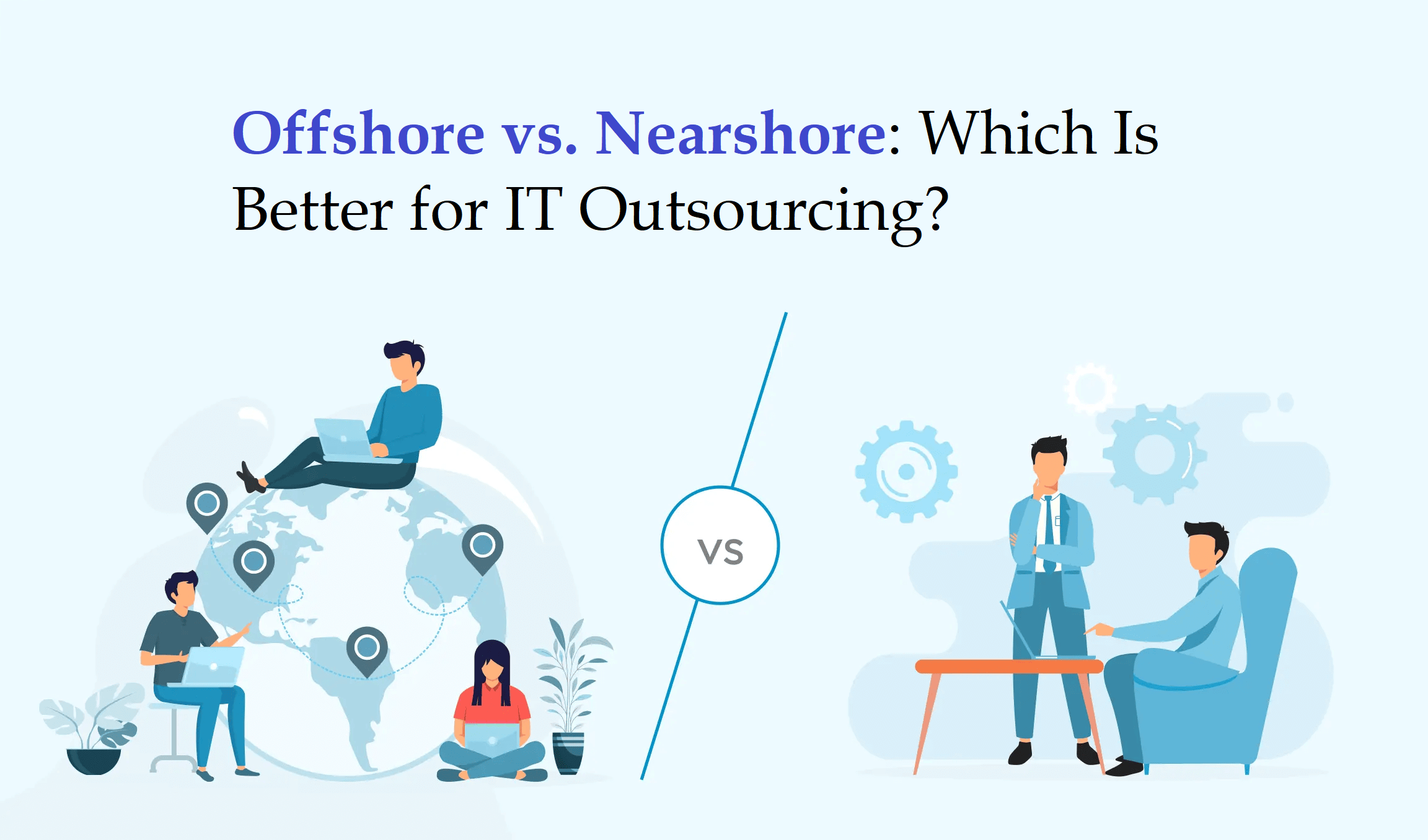Lots of companies nowadays are choosing to outsource their IT needs rather than keeping everything in-house. And it’s easy to understand why! Outsourcing can save money while still getting you access to super-talented specialists around the world. But one key decision you need to make is whether an “offshore” or “nearshore” outsourcing model makes more sense for your business.
These terms basically refer to how far away the outsourcing company is from you. Offshore means working with vendors overseas, like sending projects to India or China. Nearshore means partnering with someone closer to home, like in Mexico if you’re based in the US.
Both options come with different pros and cons though. So in this article, we’ll have a practical look at the main differences between offshore vs nearshore outsourcing. My goal is to help you better understand what might be the best fit for your own IT plans. Sound good? Then let’s dive in!
What is IT Outsourcing?
IT outsourcing just means paying an outside company to handle some or all of the IT stuff that a business needs to operate. This might include developing software, managing databases, handling security, running a help desk for employees…you name it!
Basically, any tech-related functions that a company doesn’t want to keep strictly in-house can potentially be outsourced. The goal is to tap into the skills, tools and cost savings that a specialized IT services vendor can provide.
Some examples of commonly outsourced IT functions are: building custom software or apps, testing programs to squash bugs, providing IT help desk support when employees run into issues, managing infrastructure like servers and networks, and making sure company data is secure.
The point is: Outsourcing lets you strategically use external experts to handle essential technology tasks instead of trying to do everything solo in-house. And choosing the right flavor of outsourcing (like offshore vs nearshore) is key to getting maximum value from these partnerships while keeping business risks low.
Introducing Offshore and Nearshore Models
The terms “offshore” and “nearshore” refer to where the outsourcing provider is located in relation to the client’s location.
Offshore outsourcing involves partnering with a provider in a distant foreign country, such as India, China, Philippines etc. It promises significant cost savings but also has some disadvantages.
In contrast, nearshore outsourcing makes use of a provider in a nearby foreign country, often sharing similar time zones, cultures, or languages. It seeks to combine the best of both worlds.
Now let’s explore each model in-depth.
Understanding Offshore IT Outsourcing
Let’s start by getting clear on what “offshore outsourcing” really means. This model has actually been around for ages!
Essentially, it just refers to partnering with IT companies way overseas in countries like India or China to hand off some of your tech work. For example, a business in the UK might hire an IT offshore development company in India to develop a new mobile app.
The biggest motivation here is cost savings. Labor and talent are much cheaper in developing countries compared to back home, so offshore outsourcing offers discounts of 30%, 40% or even 50% typically! And those countries have huge talent pools too, creating a win-win situation.
Some other appealing benefits:
- 24/7 Work Cycles: Time differences let work happen literally round-the-clock!
- Scalability: Massive talent pools make scaling up projects a breeze.
- Specialized Skills: Exposure to global talent platforms leads to niche expertise.
But, yeah, distance does make things complicated…
Common Offshore Outsourcing Challenges
- Major time zone gaps, language barriers, and lack of in-person visits can create messy communication challenges.
- Hidden costs like legal fees, infra, travel etc can shrink those savings.
- Sending data across borders triggers legit data security concerns these days especially.
- Monitoring quality and consistency just gets harder at a distance too.
So in a nutshell, offshore outsourcing lets you tap into talent and savings through overseas partners. But the distance introduces headaches too.
Exploring Nearshore IT Outsourcing
Nearshore IT outsourcing emerged to provide closer alignment between client and vendor for better coordination. It refers to outsourcing to companies in nearby countries.
For example, a German automotive company might outsource to an IT provider in Poland or Czech Republic. The goal is to get offshore-like cost advantages but with less distance and cultural gaps.
Key Characteristics and Advantages of Nearshore Outsourcing
Typical benefits of nearshore IT outsourcing include:
- Cultural/Language Alignment: Shared time zones, culture, and language compared to offshore sites.
- Travel Convenience: It can be easier for clients to visit provider facilities for in-person meetings.
- Data/IP Security: Keeping outsourcing regionally allows stronger legal protections.
- Common Nearshore IT Outsourcing Challenges
- Smaller Talent Pool vs. Offshore: Tap into expertise may be limited compared to global talent.
- Cost Fluctuations: Rising wages have impacted nearshore rate advantages in recent years.
- Inconsistent Quality: Quality and scalability can vary more than mature offshore sites.
Key Factors When Choosing Between Offshore vs. Nearshore
Deciding between offshore vs. nearshore outsourcing depends on multiple aspects:
Project Complexity
For simpler, well-defined IT projects nearshoring could suffice. But highly complex initiatives may need offshore scale and niche expertise.
Budget
Upfront nearshore costs are often 10-15% higher but hidden offshore expenses can even out savings. Do the math carefully!
Communication Needs
If heavy real-time collaboration is required, nearshore alignment can be preferential over offshore barriers.
Data Security
Offshoring across continents exposes more cybersecurity and compliance vulnerabilities. Nearshoring locally contains risks.
Culture & Language Fit
Nearshoring enables closer cultural alignment while offshore differences take more work to navigate.
Analyze these variables against your specific outsourcing objectives before deciding between offshore and nearshore partnerships.
Making the Offshore vs Nearshore Decision
So, how do you choose between onshore and offshore outsourcing for your IT needs? Here is a step-by-step approach:
1. Define Business Drivers
Clarify why you are outsourcing in the first place. Is it for cost savings, access to new talent pools, or the ability to scale faster? Rank the importance of each driver.
2. Analyze Project Considerations
Factor in project complexity, required speed of delivery, communication needs, compliance impacts, and other variables.
3. Compare Offshore vs. Nearshore Pros/Cons
Stack up the comparative benefits and limitations summarized earlier for both offshore and nearshore models. See which choice aligns better with your drivers.
4. Assess Provider Capabilities
Vet potential offshore and nearshore vendor capabilities through RFPs, site visits etc. against your project requirements before contracting.
Following this methodology when approaching the offshore vs nearshore decision can set your outsourcing initiatives up for success.
Stay tuned for the next section exploring emerging outsourcing trends that could impact your strategy…
The Future of IT Outsourcing
Globalization and technology advances are evolving both offshore and nearshore outsourcing capabilities in exciting ways:
Emerging Offshore Outsourcing Trends
Rising Automation: Offshore providers are using technologies like AI and RPA to further enhance productivity and cost competitiveness.
Domain Specialization: Niche focus areas around the cloud, analytics, IoT, and other high-value disciplines is deepening offshore expertise.
Security Investments: Offshore vendors are proactively addressing cybersecurity concerns through advanced data protections and compliance frameworks.
Accelerating Nearshore Advances
Closer Alignment: Nearshore engagements are becoming more embedded into client operations for tighter integration.
Higher-Value Services: Nearshore partners are expanding into more complex IT functions like architecture design and enterprise transformation.
Reskilling Programs: Providers are upskilling talent in next-gen skills like AI/ML, cybersecurity etc through training initiatives.
Technology is enabling both offshore and nearshore providers to deliver higher business impact for clients. Forward-looking companies are leveraging these trends to maximize outsourcing ROI.
Conclusion:
The choice between offshore versus nearshore ultimately depends on your specific priorities and context. Carefully analyzing project needs against provider capabilities in both locations is key to making the right strategic decision for your organization.
I hope this overview has provided a balanced perspective on weighing offshore and nearshore pros and cons.










